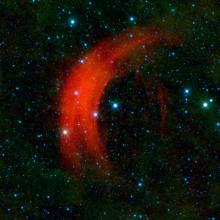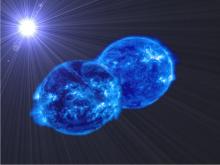Listen to today's episode of StarDate on the web the same day it airs in high-quality streaming audio without any extra ads or announcements. Choose a $8 one-month pass, or listen every day for a year for just $30.
You are here
Alpha Camelopardalis
The relationship between stars and the material around them — the interstellar medium — is complicated. Stars are born from this material — wispy clouds of gas and dust. And when stars die, they expel much of their material back into the interstellar medium, enriching it with elements forged inside the stars themselves. And between birth and death, a star can have a powerful influence on the interstellar medium around it.
An example is Alpha Camelopardalis. It’s one of the leading lights of the faint constellation Camelopardalis, the giraffe, which is in the north on December evenings.
The star is about 6,000 light-years away, so it looks faint. But it shines hundreds of thousands of times brighter than the Sun — one of the brighter stars that’s visible to the unaided eye.
Alpha Cam is probably close to 40 times the mass of the Sun. The star blows a strong “wind” of gas into space, forming a big bubble around Alpha Cam.
The star is racing through the galaxy at millions of miles per hour. As it plows through the interstellar medium, its wind squeezes the cooler gas and dust ahead of the star, forming a bow shock — like water piling up in front of a ship. The shock wave spans several light-years.
Over time, the shock wave could help squeeze the interstellar medium enough to give birth to new stars — continuing the complex relationship between the stars and the material around them.
Script by Damond Benningfield





